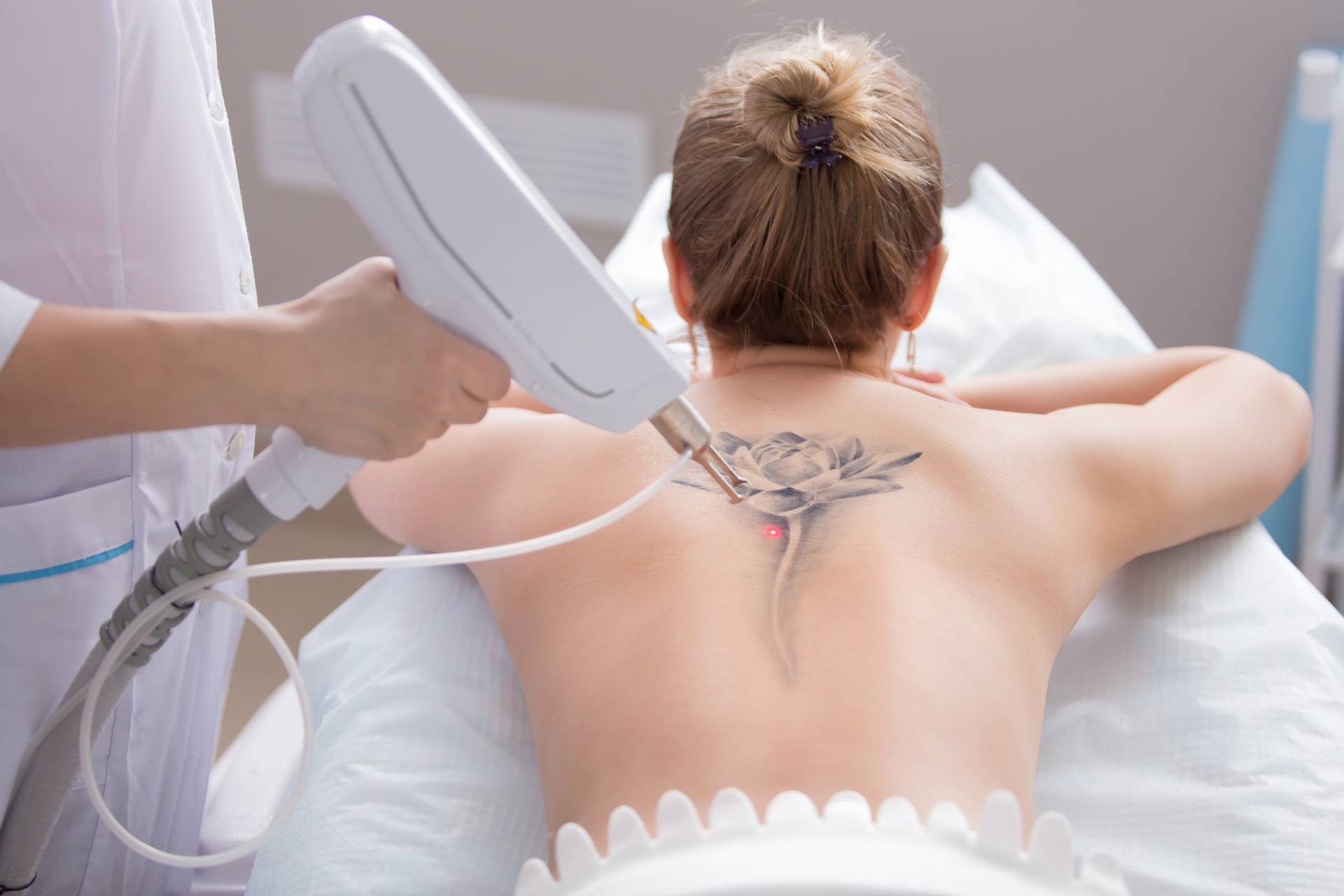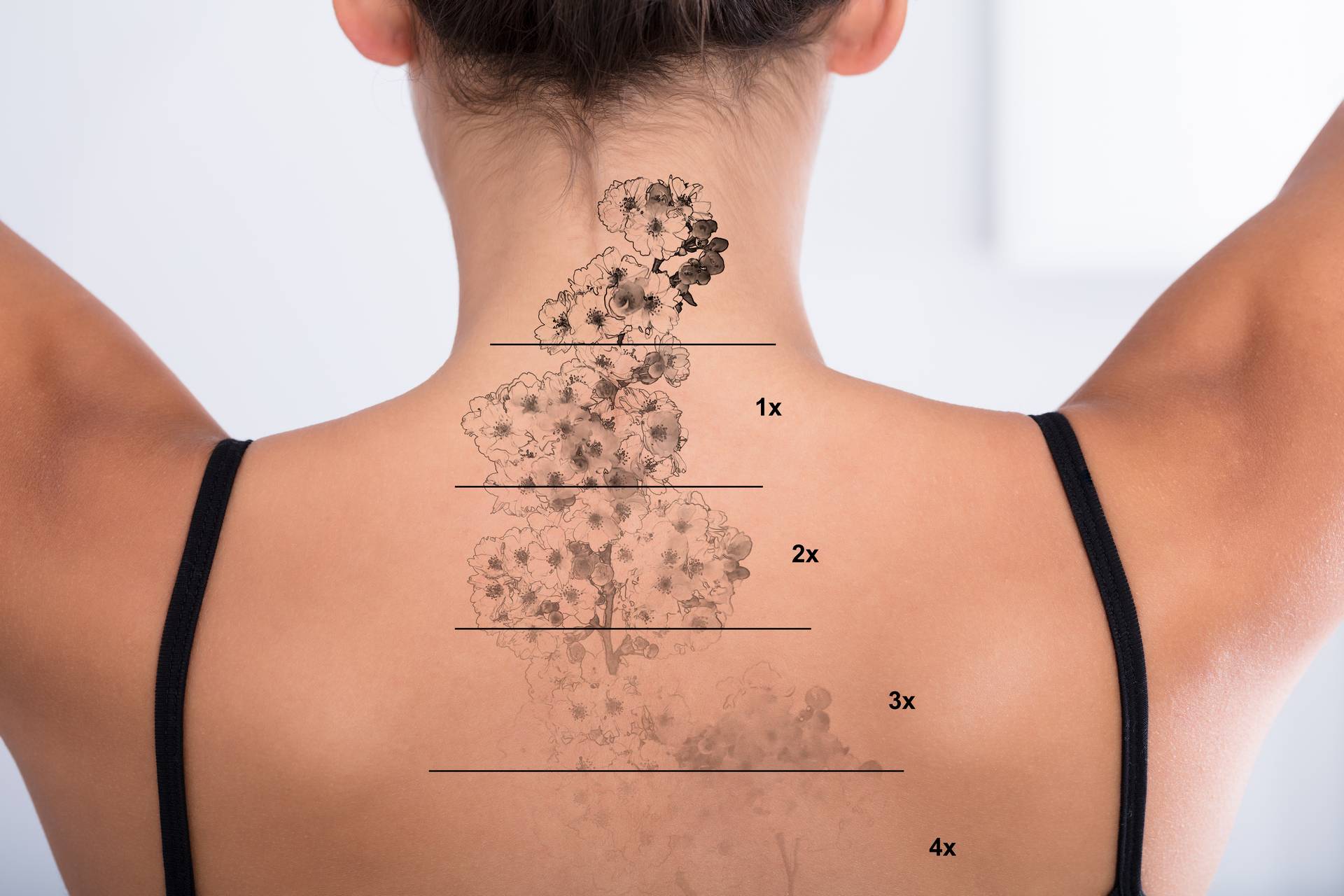Reception:
Opening hours:
Mon-Fri: 10.00 AM-6.00 PM
Sat-Sun: closed
Address in Cracow:
Cracow, Old Town
ul. Masarska 8
ul. Masarska 8
Entrance through salon Babalab from ul. Rzeźniczej next to Żabka
Access
Trams no. 18, 22, 52.

Q-Switched laser is a versatile device used in aesthetic medicine offices. It emits ultra-short, nanosecond pulses of light, which effectively remove hyperpigmentation, tattoo, permanent make-up. In addition, the laser removes hyperpigmentation, freckles and bleaching of intimate parts.
Laser removal of tattoos, permanent make-up and hyperpigmentation involves impact of a laser beam with a specific wavelength on chromatophores. They include dyes used to do permanent make-up or tattoo, as well as melanin, which is the skin pigment. Thanks to this selective laser, we can effectively remove the above-mentioned skin lesions. A Q-Switched laser procedure allows for removal of even deep deposits of pigment used for tattooing and deep and extensive hyperpigmentation. The procedure consists in holding a laser head towards selected parts of the skin, and then emitting a laser beam. The procedure takes several minutes depending on the treatment site and is performed under anaesthesia.
1
Laser tattoo removal is the most recommended method, as it is highly effective and safe. Effectiveness of a laser tattoo removal procedure depends on several factors. The most important of them include the size of the tattoo (large tattoos require more procedures), depth at which the pigment has been introduced (the deeper the pigment is introduced into the skin, the harder it is to treat it with the laser beam), even distribution of the pigment (in case of amateur tattoos, uneven distribution of the pigment is possible, which makes tattoo removal more difficult), the colour of the pigment (it is the most difficult to remove: white, green, yellow, pink, blue; it is the easiest to remove are dark pigments).
Currently, the Q-Switched laser is considered the most effective laser for tattoo removal. It is photoacoustic laser, so it does not generate a photothermal reaction. The Q-Switched laser emits 532 nm and 1064 nm wavelengths. By using these two wavelengths it can remove a wide range of pigments with which tattoos are made. The 532 nm wavelength is a visible wavelength that removes light pigments. While the 1064 nm beam excellently removes dark pigments. The pigment particles are broken down, encapsulations formed around the pigment is removed, topical inflammation develops and the immune cells – macrophages – remove the remaining pigment.
During each procedure, visibility of the tattoo can be reduced by about 5-20%. Due to high effectiveness of the Q-Switched laser, a tattoo may sometimes be removed after 5 procedures.
2
Permanent make-up of the eyebrows, eyelids or lips is an increasingly popular form of facial beautification, providing a long-lasting alternative to traditional make-up. Permanent eyebrow make-up is usually done to thicken the eyebrows and shape them. Another form of permanent make-up is lip make-up and lines on the eyelid. Permanent make-up can last from several months to several years. If permanent make-up does not meet your expectations, is unsuccessful or you are simply bored with it – there is a method of effective removal. The Q-Switch laser is ideal for this purpose. A number of necessary procedures depends on the extent and depth of the permanent make-up. For the full effect, we need to perform several procedures.
The Q-Switched laser causes selective photothermolysis, which means that a laser beam is absorbed by the pigment with which the permanent make-up was done. Thanks to emitting different wavelengths, the laser can remove permanent make-up done with pigments of different shades. After absorbing laser energy, the pigment disintegrates and is removed by the body’s own defence cells.
An unquestionable advantage of the Q-Switch laser is the fact that it can be used on such delicate facial areas as eyelids or lips. This is due to the effective yet safe laser operation and a reduced risk of burns. The procedure is performed under anaesthesia and during the healing process blisters and scabs may appear.
3
After the procedure, hyperpigmentation gets darker and, after a healing period it exfoliates, revealing new, brighter skin.
The Q-Switched laser emits a beam of light that is only absorbed by melanin in pigmented lesions. Selective absorption of a laser beam only by the above-mentioned chromophore (skin pigment) allows for effective, yet very safe removal of skin defects. Treatment safety is also ensured thanks to a series of special filters that controls what wavelengths are used during the procedure. This means that the risk of skin burns is minimised.
The Q-Switched laser removes many pigmented lesions of varying depths. These include freckles, lentigines, melasma, cafe au lait spots. These types of hyperpigmented lesions may appear on the face, neck and cleavage skin, hands. The procedure takes several dozen of minutes and consists of holding the laser head towards the selected skin area. After the procedure, the skin may be slightly reddened, and then the skin lesions get slightly darker to become lighter after the healing process.
Usually 3-4 procedures are required, especially if there are deep, extensive pigmented lesions. Procedures should be performed at intervals of 3-4 weeks. The procedure is performed under anaesthesia.
4
Laser bleaching of the labia, scrotum and anus is performed for aesthetic reasons. It results in improved self-esteem and psychological well-being, and can significantly improve sexual life. A darker shade of the intimate parts may be a result of individual conditions as well as hormonal changes or the influence of external factors. Therefore, intimate bleaching procedure may be desired by anyone who cares about the uniformity of colour and intimate parts bleaching.
The procedure is performed with a laser, which emits a beam of light absorbed by the skin pigment, melanin. The pigment is broken down and removed, and the skin in the treatment site becomes noticeably brighter. The pigment is removed from the body over a period of about two weeks. Restoring a lighter skin tone is not the only effect of the procedure. Q-Switched laser additionally causes skin firming and strengthening of its structure. This causes comprehensive revitalisation of the intimate parts and its sensitisation. Each procedure lasts several minutes and is preceded by the application of anaesthetic cream. We usually recommend performing several procedures (about 3-6) at intervals of one month.
The Q-Switched laser can remove tattoos of various shades very effectively. Traditional tattoo removal lasers may not be able to handle all colours, but in case of the Q-Switched laser this problem disappears. Dark shades such as black, navy blue and blue are the easiest to remove. This is because they are subjected to a wavelength of 1064 nm. This light beam is absorbed by dark pigments, which leads to breakdown of the pigment molecules and their elimination. However, there may be some problems with dyes, such as orange, red or brown, and yellow and green dyes are the most difficult is to remove. By using the Q-Switched laser, which in addition to the 1064 nm wavelength also emits a 532 nm beam, we can remove tattoos of all shades. To achieve the full effect, we need to repeat the procedure several times, sometimes even a dozen times, because each time the beam affects only a part of the pigment particles, causing their disintegration. A number of procedures depends on the dye used, how extensive the tattoo is and how deep into the skin the dye has been inserted.
The Q-Switch laser can also effectively remove permanent make-up. In such a case, we usually need fewer procedures than with laser tattoo removal. Firstly, permanent make-up is done at a shallower depth than tattoos, so it is easier to remove the dye deposits, and secondly, make-up takes smaller surface than tattoos.
In case of hyperpigmentation, the Q-Switched laser impacts on melanin, an excessively accumulated skin pigment. Under the influence of a laser light beam, melanin breaks down and is removed. Therefore, it leads to significant brightening of skin hyperpigmentation or its complete removal. A number of procedures needed varies depending on the depth and extent of hyperpigmentation. You should remember that the laser effectively reduces hyperpigmentation, but does not protect against its reappearance. And that means you need to use a UV screen.
The Q-Switched laser is also used for bleaching of the intimate parts: labia, perineum, scrotum and anus. The laser impacts melanin in the skin, making it lighter after just a few procedures at monthly intervals.
With the Q-Switch laser, we can remove permanent make-up not only from the eyebrows or lips, but we can also remove eyelid lines. In the latter case a doubt arises whether such a procedure is safe? You should not be afraid of such a procedure – as long as it is performed by a properly trained specialist, preferably a physician. Q-Switch is a certified medical device, which proves its high quality and safety. A distinguishing feature of the laser is its selective impact on chromophores, which means that it does not affect healthy tissue in any way. This reduces the risk of skin damage. Thanks to the possibility of adjusting the wavelength and power of the laser to the individual needs of the skin, we can match the parameters of the device to the specific case. A small head also increases precision of the procedure. We can aim a beam of light exactly on the area of skin where permanent make-up is
Effects may be different in different individuals. It depends on natural physiognomy, a type of pigment used as well as depth of its location. The photos show the effects after several procedures.









I highly recommend!
Before the procedure, an anaesthetic ointment is applied to significantly reduce pain sensations, making the procedure virtually painless. A specialist chooses the best laser head for the tattoo’s colour and then starts the procedure, during which the Patient wears protective glasses.

The effect of the Q Switch laser is selective impact of a laser beam on the pigment. By generating a thermal effect, laser energy is absorbed by a tattoo/permanent make-up dye or skin melanin. This leads to breakdown of the dye and its removal. Thanks to selectivity of photothermolysis, we can effectively reduce hyperpigmentation or remove tattoos without burning the skin or causing post-treatment scars. The effects of tattoo removal depend primarily on a type of dyes used and the depth to which they were introduced into the skin. We usually recommend a series of 6-10 procedures. In case of hyperpigmentation, a number of required procedures is even halved.
The procedure does not require much preparation.
Do not consume alcohol, caffeine or drugs 24 hours before the procedure.
Do not sunbathe for a week before the procedure.
Post-procedure redness and swelling usually disappears within 2 days. Very strong pigmentation of tattoos may cause blisters that later turn into scabs and also oozing of the plasma.
There are not many contraindications to Q-Switch laser procedures but they must be taken into consideration. Below you will find the most important of them.
Diabetes.
In case of advanced diabetes wound healing is impaired. However, when treated and controlled, diabetes is not a problem. If you have diabetes, please ask your attending physician for a written consent for the cosmetic medicine procedure and present it to us on the day of the procedure.
Active cancer.
Cancer that occurred less than 5 years prior to the procedure.
Chemo- and radiotherapy
Steroids, except asthma medications and inhaled steroids, taken less than one month prior to the scheduled procedure.
Fungal medications or antibiotics taken less than one week prior to the procedure.
Tendency to keloids.
haemophilia.
Epilepsy.
Pregnancy and breastfeeding. We do not perform procedures in pregnant ladies or nursing mothers, even with the physician’s consent. When it comes to children, one can’t be too careful!
Asymptomatic HIV infection or active AIDS.
Skin diseases in the planned treatment site.
Fever, viral or bacterial infection on the day of the procedure.
Our clinic was established in 2005, which has allowed us to gain extensive experience. We have already performed over 35,000 treatments. Our metamorphoses are known as the most spectacular in Poland. We can easily create very natural or extremely expressive effects for you.
At Princesse® we use only the highest quality preparations coming directly from the manufacturers. The high quality of services is confirmed by over 800 customer opinions collected on Booksy and Facebook, the average of which is 5/5.
In our treatments, we focus on strict adherence to procedures - regardless of which practician you choose, you will encounter the same advanced treatment techniques, which is due to our high staff requirements.
Princesse® is a modern aesthetic medicine clinic and training centre. It was established in 2005. Thanks to extensive experience and over 35,000 procedures performed to date, we have been able to select only the best procedures and equipment.
Princesse® employs highly specialised medical and cosmetology staff, who continue to improve their skills by participating in seminars and conferences devoted to the fields they practice, both in Poland and worldwide.
At Princesse®, we focus on naturalness and perfection as well as spectacular effects presented by models and celebrities. We believe that aesthetic medicine procedures are meant not to be a disguise, but to emphasise and highlight the strengths that each of us has.

Mon-Fri: 10.00 AM-6.00 PM
Sat-Sun: closed
Cracow, Old Town
ul. Masarska 8
ul. Masarska 8
Entrance through salon Babalab from ul. Rzeźniczej next to Żabka
Trams no. 18, 22, 52.